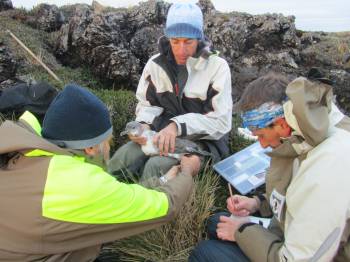One of the least-known ACAP-listed species, the Grey Petrel Procellaria cinerea, is now being studied at South Africa's Marion Island in the southern Indian Ocean.
As part of a larger project on burrowing petrels led by Peter Ryan (FitzPatrick Institute, University of Cape Town) that has commenced this year the eastern side of the island is being searched for occupied nests of this winter-breeding and (at Marion) rare bird.
Once found, incubating birds are being fitted with miniature GPS devices weighing only 16 g and with 2-g time,depth, temperature and light recorders by visiting scientist Yan Ropert-Coudert (Institut Pluridisciplinaire Hubert Curien - DEPE, Universite de Strasbourg, France).
To date 15 nests have been found, mainly in rocky crevices among vegetated ground close to the coast. So far five birds have had devices placed on them.

Ben Dilley holds a Grey Petrel as Mike Schramm reads its leg band
and Yan Ropert-Coudert takes notes.
Photograph by Delia Davies
Searches for sites are being greatly helped by the presence of Mike Schramm (NISC South Africa) who studied burrowing petrels on Marion Island in the early 1980s towards his MSc degree. Mike has returned to the island on the annual relief now underway after a gap of three decades to lend his expertise and knowledge to the study.
Ben Dilley (MSc student) and Delia Davies, both with the FitzPatrick Institute, will be overwintering on Marion and will continue to follow the fortunes of the study nests through the breeding season.
The overall study aims to look at whether burrowing petrels on Marion are showing signs of recovery after the eradication of feral cats Felis silvaticus catus on the island in the early 1990s.
Selected References:
Bester, MN, Bloomer, JP, Bartlett, PA, Muller, DD, van Rooyen, M & Büchner, H 2000. Final eradication of feral cats from sub-Antarctic Marion Island, southern Indian Ocean. South African Journal of Wildlife Research 30: 53-57.
Bester, MN, Bloomer JP, van Aarde, RJ, Erasmus, DG, van Rensburg, PJJ, Skinner, JD, Howell, PG & Naude, TW 2002. A review of the successful eradication of feral cats from sub-Antarctic Marion Island, southern Indian Ocean. South African Journal of Wildlife Research 32: 65-73.
Newton, I.P. & Fugler, S.R. 1989. Notes on the winter-breeding Great-winged Petrel Procellaria macroptera and Grey Petrel Procellaria cinerea at Marion Island. Marine Ornithology 23: 27-34.
Schramm, M. 1986. Burrow densities and nest site preferences of petrels (Procellariidae) at the Prince Edwrd Islands. Polar Biology 6: 63-70.
With thanks to Yan Ropert-Coudert, Peter Ryan and Mike Schramm for information.
John Cooper, ACAP Information Officer, 9 May 2012

 English
English  Français
Français  Español
Español